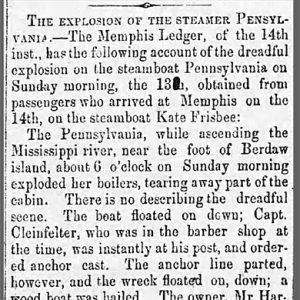calsfoundation@cals.org
Pennsylvania [Steamboat]
The Pennsylvania was a steamboat that burst a boiler and burned on the Mississippi River near Ship Island north of Helena (Phillips County) on June 13, 1858, resulting in the deaths of 160 passengers and crew members, including the younger brother of famed author Mark Twain.
The Pennsylvania was a 486-ton sidewheel paddleboat. Its hull was constructed at Shousetown, Pennsylvania, and it was finished out at Pittsburgh, Pennsylvania, in 1854. The Pennsylvania was 247 feet long and thirty-two feet wide with a 6.3-foot draft. It originally ran between Pittsburgh and Cincinnati, Ohio, but in 1858 switched to runs between St. Louis, Missouri, and New Orleans, Louisiana. John Klinefelter was the steamboat’s captain.
Samuel Clemens, who wrote under the pen name Mark Twain, was a cub pilot on the Pennsylvania until he left the vessel following an argument with an officer. His younger brother Henry was a clerk on the steamboat.
The Pennsylvania was steaming up the Mississippi River on June 13, 1858, with around 400 passengers and crew, including many German immigrants, when its boilers exploded near Ship Island around 6:00 a.m., blowing away part of the deck. Klinefelter, who was in the ship’s barbershop when the explosion occurred, ordered the anchor lowered, but its rope broke and the burning wreck drifted down the Mississippi.
George C. Harrison was stacking wood at his woodyard and witnessed the explosion, immediately setting out on a flatboat with his father to help the victims of the Pennsylvania disaster. They took people off the stricken steamboat until flames threatened to engulf them. Young Charles Harrison used a skiff to rescue sixteen people who had been blown into the water.
The remains of the Pennsylvania drifted to Ship Island and lodged there. The steamboat Imperial approached at around 1:00 p.m. and towed the hulk to Austin, Mississippi, where the survivors received aid. The Kate Frisbee arrived at the disaster scene around 4:00 p.m. and took other survivors to Memphis, Tennessee.
Among them was Henry Clemens, who was badly scalded in the explosion. When his older brother Samuel heard of the explosion, he set out from New Orleans aboard the A. T. Lacey. He arrived at Memphis in time to tend to his brother, who died of his injuries on June 21.
The St. Louis Board of Steamboat Inspectors examined the accident and concluded that engineer Francis Doris was responsible for the explosion through “negligence and inattention on his part,” recommending that he be barred from future service as an engineer.
The Pennsylvania catastrophe is one of many examples of the dangers of steamboat travel in Arkansas waters in the nineteenth century, where boiler explosions also caused mass casualties on the Car of Commerce in 1828, the Rob Roy in 1836, the Persian in 1840, the St. Joseph in 1850, the J. Wilson in 1853, the Sultana in 1865, and the Miami in 1866.
For additional information:
“The Explosion of the Steamer Pennsylvania.” Opelousas [Louisiana] Courier, June 26, 1858, p. 2.
“The Loss of Life by the Explosion on the Steamboat Pennsylvania.” Times-Picayune [New Orleans], July 27, 1858, p. 2.
Panhorst, John, Jr. “The Steamboat Pennsylvania.” Phillips County Historical Quarterly 19 (December 1980/March 1981): 35–37.
“The Pennsylvania.” Times-Picayune, August 17, 1858, p. 1.
Tappan, T. E. “Coincidences Come in Threes.” Phillips County Historical Quarterly 19 (December 1980/March 1981): 38–41.
Tappan, Thomas E. “Boiler Explosion on the Steamer Pennsylvania.” Phillips County Historical Quarterly 19 (June/September 1980): 22–29.
“Terrible Boiler Explosion.” Times-Picayune, June 14, 1858, p. 1.
Twain, Mark. Life on the Mississippi. New York: Harper Brothers Publications, 1874.
Way, Frederick, Jr. Way’s Packet Directory. Athens: Ohio University Press, 1983.
Mark K. Christ
Central Arkansas Library System
 Louisiana Purchase through Early Statehood, 1803 through 1860
Louisiana Purchase through Early Statehood, 1803 through 1860 Transportation
Transportation Pennsylvania Steamboat Article
Pennsylvania Steamboat Article  Pennsylvania Steamboat Article
Pennsylvania Steamboat Article 



Comments
No comments on this entry yet.